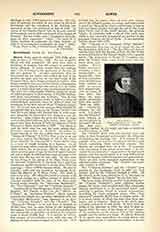

Goya y Lucientes , FRANCISCO JOSÉ DE, painter and etcher, b. in Fuendetodos, Aragon, Spain, March 31, 1746; d. in Bordeaux, April 16, 1828. His father was a small landowner and could give only a meagre education to his son. It is more than probable that a monk of Santa Fé awakened the latent art in the boy; and certain it is that when fourteen, he painted frescoes in the Church of Fuendetodos, and a year later began regular art studies with Martinez. Going to Saragossa he entered the San Luis Academy, where for four or five years he worked under Luxan, and then went to Madrid. When only twenty years old, he left for Italy and worked his way to Rome as a bull-fighter. In Italy he painted little, yet he won a prize at Parma for a “Hannibal seeing Italy from the Alps”, and completed in a few hours a full-length portrait of Pope Benedict XIV, now in the Vatican. On Goya’s return to Spain (1775), Mengs was so impressed with his talents that he commissioned him to make sketches for the Prado and Escorial tapestries, and Goya was thereby brought into contact with the court, lived for the rest of his life among princes and became the most brilliant member of the circle of Don Luis, the king’s brother. He married (1775) Josefa, daughter of Bayeu, painter to Charles III, by whom he had twenty children. Five small canvases (all in San Fernando) painted at this time are strikingly original in composition, and have a marvellous silvery quality rivalling that of Velasquez. In 1780 he was made a member of the Fernando Academy in recognition of his “Christ Crucified” (Prado) and his “St. Francis on the Mountain”. He was now the acknowledged leader of the Spanish School, and well named the last of the old masters and the first of the new. He painted portraits with the greatest facility and rapidity—all marvellous resemblances—and over two hundred grandees, poets, scholars, and great ladies of the court sat to him. Notable among these canvases are those of Queen Maria Luisa, Charles IV and his family, Dona Maria Josefa, and Queen Isabella of Sicily, the last two celebrated for their beautiful and tender representation of maidenhood. In 1789 Goya was appointed pintor de camera of Charles IV with an income of $2500 a year, and in 1795 was unanimously elected director of the Madrid Academy.
Goya painted frescoes in the churches of Seville, Valencia, Saragossa, Toledo, and Madrid, those in S. Antonio de la Florida (Madrid) being especially notable for their grace and movement. His paintings, other than portraits and religious works, portray the life of Spain, and exhibit his immense vitality, restlessness, energy, audacity and unaffectedness. His technique was a complete overthrow of tradition. Impetuous and intolerant, he sought etching as a means of expression. The “Capriccioso”, begun in 1792, appeared in 1796.In this series dedicated to the king, he pilloried the prevailing vices and absurdities with a subtler and more bitter needle than Callot’s and a spirit less commonplace than Hogarth’s. He is often called the Spanish Rabelais. Goya almost invariably used aquatint to give “depth” and suggest planes in these etchings, and every one of these eighty plates Delacroix is said to have copied. The “Miseries of War” followed these and are far more serious in conception. Many of them suggest Rembrandt’s methods. He began lithography in Madrid, and the first important artistic drawing ever made on stone was by Goya, and this, too, when he was seventy-three.
Ferdinand VII, at his restoration in 1814, invited Goya to his court; but, unhappy, totally deaf, and growing blind, he left Madrid on the completion of his most important ecclesiastical work, “St. Joseph of Calasanz”, for the church of S. Anton Abad, and settled in Bordeaux. Here in his eightieth year he lithographed the notable series of bull-fights. Goya was the strongest figure in the age of tumult and change in which he lived, the last link between tradition and the great movement in art of the nineteenth century, which he epitomized when he said: “a picture, the effect of which is true, is finished.” He was buried in Bordeaux. One son, of all his children, survived him. His other works are: double portrait of La Maja, in the San Fernando Academy; portrait of Duchess of Alva, in the Louvre; a collection of etchings and aquatints in the British Museum; equestrian portrait of Charles IV, in Madrid; sanguine drawing of Duke of Wellington, in the British Museum.
LEIGH HUNT

